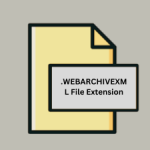.SWZ File Extension

Adobe Flash Player Cache File
| Developer | Adobe Systems |
| Popularity | |
| Category | Web Files |
| Format | .SWZ |
| Cross Platform | Update Soon |
What is an SWZ file?
The .SWZ file extension represents Adobe Flash Player cache files, which are integral to the operation and performance of Adobe Flash Player.
These files are used to store data and resources that help in the efficient rendering of Flash content in web browsers.
As Flash technology has declined in popularity, understanding these files is important for those maintaining legacy systems or attempting to recover data from older Flash-based applications.
More Information.
Adobe Flash Player was first released in 1996, and it quickly became popular for its ability to deliver rich multimedia experiences, including animations, games, and interactive applications. As Flash content became more complex, Adobe introduced various optimizations, including caching mechanisms to improve loading times and performance. The .SWZ file extension was introduced to handle cache storage for larger and more complex Flash applications.
The initial purpose of the .SWZ files was to act as a cache for Flash Player’s runtime environment.
They stored compiled versions of ActionScript code and other resources required by Flash applications, which allowed for quicker loading and smoother user experiences by reducing the need to recompile code and reload assets from the server repeatedly.
Origin Of This File.
The .SWZ file format is associated with Adobe Flash Player, a multimedia software platform that was once widely used for creating and viewing interactive content on the web.
Adobe Flash Player, originally developed by FutureWave Software under the name SmartSketch, was acquired by Adobe Systems in 1996 and rebranded as Flash.
The .SWZ file type emerged as part of Flash Player’s evolution to enhance performance and manage cache more effectively.
File Structure Technical Specification.
The .SWZ file format is a binary file that encapsulates various elements essential for Flash Player’s operation. The file structure of a .SWZ file typically includes:
- Header Information: Contains metadata about the file, including version information and file size.
- Compressed Data Sections: Stores compiled ActionScript code and other resources, such as graphics and audio, in a compressed format to save space and enhance performance.
- Index Tables: Provide references to different parts of the cached data, allowing Flash Player to quickly locate and retrieve the required resources.
- Data Blocks: Contain the actual Flash content data, organized in blocks for efficient access and retrieval.
The technical specifications of .SWZ files include:
- Compression Format: .SWZ files use compression algorithms to reduce the size of stored data. This often involves zlib compression or similar methods.
- Binary Format: The data within a .SWZ file is stored in a binary format, which is not directly readable by text editors but can be parsed by specialized tools or Flash Player itself.
- Compatibility: .SWZ files are designed to work specifically with Adobe Flash Player, and their structure is optimized for performance within this environment.
How to Convert the File?
Converting .SWZ files to other formats are not straightforward due to their specialized nature and the fact that Flash technology is no longer widely supported. If you need to convert .SWZ files, you can consider the following approaches:
- Extract Flash Content: Use tools like SWF Decompiler to extract content from .SWZ files. This can allow you to retrieve Flash assets and convert them into more accessible formats, such as SWF files.
- Use Legacy Software: Some older tools and software that still support Flash Player might be able to work with .SWZ files. These tools may offer limited conversion options or allow you to access the content directly.
- Manual Extraction: In some cases, it may be possible to manually extract data from .SWZ files using a hex editor and custom scripts. This approach requires technical expertise and a thorough understanding of the file structure.
Advantages And Disadvantages.
Advantages:
- Improved Performance: By caching compiled code and resources, .SWZ files significantly improve the performance of Flash applications, reducing load times and enhancing user experience.
- Efficient Resource Management: Caching allows for efficient management of resources, reducing the need for repeated downloads and processing of the same data.
- Reduced Server Load: Since .SWZ files store data locally on the user’s machine, they help reduce the load on web servers, improving overall efficiency and reducing bandwidth usage.
Disadvantages:
- Deprecation of Flash: Adobe Flash Player has been officially deprecated as of December 31, 2020. This means that .SWZ files are becoming obsolete, and support for Flash Player is limited, which can pose challenges for accessing or using older content.
- Security Risks: Flash Player has been associated with various security vulnerabilities over the years. As a result, .SWZ files could potentially be a vector for malware or other security issues if not properly managed.
- Limited Compatibility: .SWZ files are specifically designed for Flash Player and may not be compatible with other applications or systems. This can make it difficult to work with these files in modern environments.
How to Open SWZ?
Open In Windows
- Adobe Flash Player: Historically, .SWZ files could be opened and used by Adobe Flash Player. However, with Flash Player no longer supported, opening .SWZ files directly may require legacy software or workarounds.
- SWF Tools: Tools like SWF Decompiler or SWF Player might be able to work with .SWZ files, allowing you to view or extract content.
Open In Linux
- Flash Player Alternatives: On Linux, you may need to use alternative software or emulators to work with .SWZ files. Flash Player was not officially supported on Linux, so finding compatible tools may be challenging.
- Extraction Tools: Some command-line tools or custom scripts may help extract or work with content from .SWZ files on Linux systems.
Open In MAC
- Adobe Flash Player: Similar to Windows, Adobe Flash Player was the primary tool for interacting with .SWZ files on macOS. With the end of Flash support, alternative solutions may be necessary.
- Legacy Software: Some older applications that supported Flash content may still work with .SWZ files on macOS.













